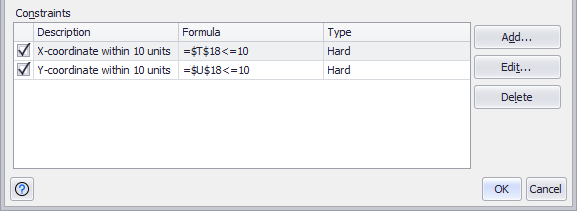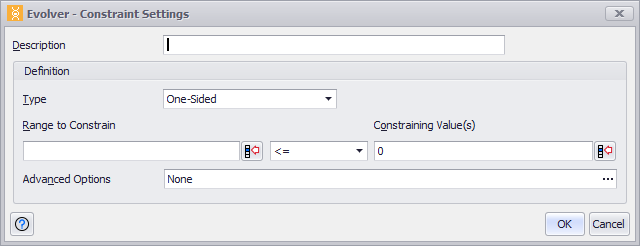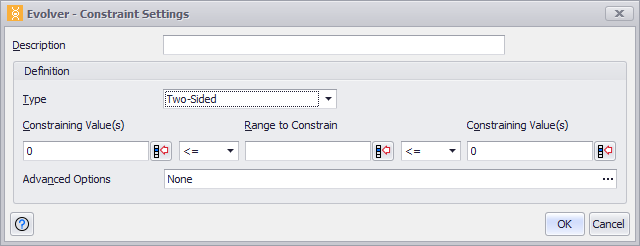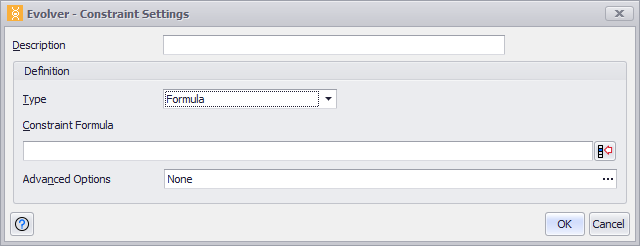Constraints
Evolver models can include constraints, or conditions that must be satisfied for a solution to be valid. Constraints are shown in the Constraints table (Figure 1, right) at the bottom of the Model Definition dialog.

Figure 1 - Constraints Panel
The Constraints table consists of four columns:

Figure 2 - Constraint Settings Window
To add a constraint, click the Add button. This will open the Constraint Settings window (Figure 2, right), where the constraint can be configured. See Configuring a Constraint, below, for more information.
To edit an existing constraint, select the constraint by clicking inside its row (not the check box to the left) and click the Edit button.
To delete an existing constraint, select the constraint by clicking inside its row (not the check box to the left) and click the Delete button.
Configuring a Constraint
The Constraints Setting dialog (Figures 2) contains options for specifying conditions that must be met for an optimization trial solution to be considered valid.
The Type option controls the overall format of this dialog. The One-Sided (Figure 2) and Two-Sided (Figure 3) entry styles are very similar, while the Formula (Figure 4) entry style is quite different.

Figure 3 - Constraint Settings Window - Two Sided Entry

Figure 4 - Constraint Settings Window - Formula Entry
One-Sided and Two-Sided Constraint Entry
In these styles, constraints are entered by specifying one or more cells to constrain, the values they should be constrained by, and various options that specify how and when the constraints are evaluated.
Constraint configurations include the following settings:
Description – Text that can be used to make the constraint more readable.
Definition - Configurations for the constraint.
Type - The type of constraint - One-Sided, Two-Sided, or Formula. See Formula Constraint Entry, below, for more information on that type of constraint.
Range to Constrain – Specifies the cell or cells that must meet a condition.
One-Sided and Two-Sided styles allow constraints to be entered using logical operators - < (less than), <= (less than or equal to), > (greater than), >= (greater than or equal to) or = (equals).
Constraining Value(s) – Specifies the value or values to which the Range to Constrain field must be restricted. A number, a cell, or a range of cells can be entered; a range with multiple cells will specify a different bound for each cell in the Range to Constrain. In the two-sided format, there can be both an upper and lower bound specified. In the one-sided format, only one bound will be available.
Advanced Options - Displays any additional options for the constraint. Use the More button (…) to open the Constraint Advanced Options window; see below for more information.
Please note: if no Advanced Options are set for a constraint, the constraint will default to a Hard constraint with Precision set to 'Automatic'
Formula Constraint Entry
A Formula constraint allows a constraint to use any valid Excel formula. For example, the formula
=IF(A1>100, B1>0, B1<0)
is a constraint that requires the value in cell B1 to be positive or negative depending on the value in cell A1. Alternatively, the formula can be entered in a cell; if that cell is C1, for example, then you can enter =C1 in the Formula field of the Constraint Settings dialog.
In general, entering constraints in the One-Sided or Two-Sided style helps Evolver find the optimal solution faster. Only use the Formula entry method in cases where it is not possible to use the other entry styles. The formula discussed above could be entered in cell D1 as:
=IF(A1>100, B1, -B1)
Then a simple One-Sided constraint can be added, requiring that D1>0.